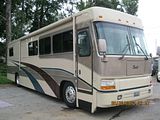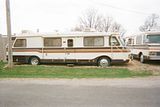Go to...  | Start A New Topic  | Search  | Notify  | Tools  | Reply To This Topic  |  |
Looking to purchase a 1994 36’ that the Owner says doesn’t Cool very well on a hot day and has to use a Portable Unit. Any suggestions or is this a Normal Problem? Thanks | |||
|
 3/22 3/22 |
suggestion put in atwood ceiling units Dana & Lynn 1997 38ft Monarch front entry Spartan Mountain Master Chassis Cummins 8.3 325hp Allison MD-3060 6 speed 22.5 11R Cummins Factory Exhaust Brake 8000 watt Quiet Diesel Generator 9608-M0022-38MI-4C Christened Midnight 1972 22ft 72081169MC22C Christened Camp Barth | |||
|
Thanks for the information, but I was hoping their was an upgrade available for the Basement Unit. I want to keep it Original Looking and Don’t feel like Cutting the Roof open. Packard | ||||
|
 |
Coleman has a basement AC unit that has (2) 13500 compressors that are adaptable and they say will replace the ones used in Barth coaches. Ed | |||
|
Thanks Ed. I didn't purchase it yet. That was the only the Seller told me about the Coach | ||||
|
 |
you could use these? http://www.rvproductsshop.com/...0-btu-46515-811.html http://busconversion101.com/Ai...ing.htm#Cruisair-top _________________________ The 82 MCC {by Barth} is not an rv-- it is a Motor Coach!! | |||
|
Hello! Insufficient air conditioning cooling in a 36-foot motorhome from 1994 is indeed a very common issue, especially for vehicles of that era. This is typically not caused by a single factor but rather a combination of several factors: Aging air conditioning system: After nearly 30 years, the efficiency of the compressor, condenser, and evaporator has inevitably declined significantly. The refrigerant (likely the now-phased-out R22) may also be leaking or insufficient. Reduced insulation performance: The seals around the doors and windows of older vehicles may have deteriorated, and the insulation materials in the vehicle body may have failed or be insufficient, leading to significant loss of cool air and a high thermal load. Insufficient power (especially for large spaces): Even back then, 36 feet was a large space, and the original factory air conditioning system's power (typically around 13,500 BTU) was already struggling to cool the entire vehicle in extreme heat, and efficiency declines make it even more inadequate. Roof air conditioning location/duct design: Older designs may not be as efficient as modern air conditioning systems, leading to uneven distribution of cool air. Using a portable air conditioner as a ‘quick fix’ is a common practice among previous owners, but this is often a Band-Aid solution with numerous drawbacks: it occupies valuable interior space, requires opening windows or drilling holes for heat dissipation (compromising the seal), produces significant noise, has high energy consumption (potentially requiring an additional generator), and a single portable unit struggles to evenly cool a 36-foot-long space. My recommendation: Proceed with caution: If you are very fond of this vehicle, include the cost of a thorough inspection and upgrade of the air conditioning/insulation system in your budget, as this is likely to be a significant expense. Core solution: Assessment and repair: First, have a professional RV air conditioning technician thoroughly inspect the original roof-mounted air conditioning system. If core components like the compressor are in good condition, improvements may be possible through deep cleaning, replacing seals, replenishing appropriate refrigerant (which may require modification to accommodate new environmentally friendly refrigerants), and optimising airflow. However, the performance ceiling of older systems is relatively low. Upgrade the air conditioning: A more realistic solution is to upgrade the roof-mounted air conditioning unit. Modern high-efficiency air conditioning systems (15,000 BTU or higher) have significantly higher energy efficiency ratios and are specifically designed for large spaces. When replacing the unit, ensure compatibility with the roof's load-bearing capacity and opening dimensions. Enhance insulation: Inspect and replace aged door and window seals, and consider adding reflective insulation curtains/films to the windows. If the budget allows, assess the condition of the vehicle's insulation layer and reinforce it if necessary (this is the foundation for improving overall cooling/heating efficiency). Alternative solution: If there are still local hotspots after upgrading the roof air conditioning unit, consider installing a dedicated, high-efficiency second air conditioning unit (either a split-type or another roof unit) in frequently used areas (such as the bedroom). This is far more effective, quieter, and space-saving than a portable air conditioner. For an in-depth analysis of RV air conditioning, a comparison of the pros and cons of different solutions, and guidance on selecting modern air conditioning models suitable for retrofitting older vehicles, I have compiled numerous specialised articles and purchasing guides on my website, particularly targeting air conditioning issues for older models and large-space RVs. If you are interested in learning more, please visit the site for more specific reference information: https://www.rvacunit.com/product-category/rv-ac-unit/ Purchasing an older vehicle is a nostalgic choice, but air conditioning is absolutely essential for comfort in hot regions. It is crucial to plan your solution in advance. Wishing you a smooth decision-making process! | ||||
|
| Powered by Social Strata |
| Please Wait. Your request is being processed... |
|
This website is dedicated to the Barth Custom Coach, their owners and those who admire this American made, quality crafted, motor coach.
We are committed to the history, preservation and restoration of the Barth Custom Coach.
We are committed to the history, preservation and restoration of the Barth Custom Coach.

